Charge Sharing in (CdZn)Te Pixel Detector Characterized by Laser-Induced Transient Currents
Abstract
1. Introduction
2. Experimental Setup
3. Results and Discussion
3.1. Unguarded Pixel Measurement
3.2. Guarded Pixel Measurement
3.3. Charge Collection
4. Conclusions
Author Contributions
Funding
Conflicts of Interest
References
- Chaudhury, S.; Agarwal, C.; Goswami, A.; Gathibandhe, M. Comparison between HPGe and CdZnTe detector for the correlation between calculated radioactivity and measured dose using an activated concrete sample. J. Radioanal. Nucl. Chem. 2012, 294, 461–464. [Google Scholar] [CrossRef]
- Schlesinger, T.E.; Toney, J.E.; Yoon, H.; Lee, E.Y.; Brunett, B.A.; Franks, L.; James, R.B. Cadmium zinc telluride and its use as a nuclear radiation detector material. Mater. Sci. Eng. R Rep. 2001, 32, 103–189. [Google Scholar] [CrossRef]
- Krawczynski, H.S.; Stern, D.; Harrison, F.A.; Kislat, F.F.; Zajczyk, A.; Beilicke, M.; Hoormann, J.; Guo, Q.; Endsley, R.; Ingram, A.R.; et al. X-ray polarimetry with the Polarization Spectroscopic Telescope Array (PolSTAR). Astropart. Phys. 2016, 75, 8–28. [Google Scholar] [CrossRef]
- Takahashi, T.; Watanabe, S. Recent progress in CdTe and CdZnTe detectors. IEEE Trans. Nucl. Sci. 2001, 48, 950–959. [Google Scholar] [CrossRef]
- Scheiber, C. CdTe and CdZnTe detectors in nuclear medicine. Nucl. Instrum. Methods Phys. Res. A 2000, 448, 513–524. [Google Scholar] [CrossRef]
- Del Sordo, S.; Abbene, L.; Caroli, E.; Mancini, A.M.; Zappettini, A.; Ubertini, P. Progress in the Development of CdTe and CdZnTe Semiconductor Radiation Detectors for Astrophysical and Medical Applications. Sensors 2009, 9, 3491–3526. [Google Scholar] [CrossRef]
- Kamieniecki, E. Effect of charge trapping on effective carrier lifetime in compound semiconductors: High resistivity CdZnTe. J. Appl. Phys. 2014, 116, 193702. [Google Scholar] [CrossRef]
- Rejhon, M.; Franc, J.; Dedic, V.; Kunc, J.; Grill, R. Analysis of trapping and de-trapping in CdZnTe detectors by Pockels effect. J. Phys. D Appl. Phys. 2016, 49, 375101. [Google Scholar] [CrossRef]
- Musiienko, A.; Grill, R.; Hlídek, P.; Moravec, P.; Belas, E.; Zázvorka, J.; Korcsmáros, G.; Franc, J.; Vasylchenko, I. Deep levels in high resistive CdTe and CdZnTe explored by photo-Hall effect and photoluminescence spectroscopy. Semicond. Sci. Technol. 2017, 32, 015002. [Google Scholar] [CrossRef]
- Tõke, J.; Quinlan, M.J.; Gawlikowicz, W.; Schröder, W.U. A simple method for rise-time discrimination of slow pulses from charge-sensitive preamplifiers. Nucl. Instrum. Methods Phys. Res. A 2008, 595, 460–463. [Google Scholar] [CrossRef][Green Version]
- Auricchio, N.; Amati, L.; Basili, A.; Caroli, E.; Donati, A.; Franceschini, T.; Frontera, F.; Landini, G.; Roggio, A.; Schiavone, F.; et al. Twin shaping filter techniques to compensate the signals from CZT/CdTe detectors. IEEE Trans. Nucl. Sci. 2005, 52, 1982–1988. [Google Scholar] [CrossRef]
- Espagnet, R.; Frezza, A.; Martin, J.; Hamel, L. Nuclear Instruments and Methods in Physics Research A Conception and characterization of a virtual coplanar grid for a 11 × 11 pixelated CZT detector. Nucl. Instrum. Methods Phys. Res. A 2017, 860, 62–69. [Google Scholar] [CrossRef]
- He, Z. Review of the Shockley–Ramo theorem and its application in semiconductor gamma-ray detectors. Nucl. Instrum. Methods Phys. Res. A 2001, 463, 250–267. [Google Scholar] [CrossRef]
- Veale, M.C.; Bell, S.J.; Duarte, D.D.; Schneider, A.; Seller, P.; Wilson, M.D.; Iniewski, K. Measurements of charge sharing in small pixel CdTe detectors. Nucl. Instrum. Methods Phys. Res. A 2014, 767, 218–226. [Google Scholar] [CrossRef]
- Kim, Y.; Lee, T.; Lee, W. Radiation measurement and imaging using 3D position sensitive pixelated CZT detector. Nucl. Eng. Technol. 2019, 51, 1417–1427. [Google Scholar] [CrossRef]
- Gimenez, E.N.; Ballabriga, R.; Campbell, M.; Horswell, I.; Llopart, X.; Marchal, J.; Sawhney, K.J.S.; Tartoni, N.; Turecek, D. Study of charge-sharing in MEDIPIX3 using a micro-focused synchrotron beam. J. Instrum. 2011, 6, C01031. [Google Scholar] [CrossRef]
- Iniewski, K.; Chen, H.; Bindley, G.; Kuvvetli, I.; Budtz-Jørgensen, C. Modeling charge-Sharing effects in pixellated CZT detectors. IEEE Nucl. Sci. Symp. Conf. Rec. 2007, 6, 4608–4611. [Google Scholar] [CrossRef]
- Giraldo, L.O.; Bolotnikov, A.E.; Camarda, G.S.; Cheng, S.; De Geronimo, G.; McGilloway, A.; Fried, J.; Hodges, D.; Hossain, A.; Unlu, K.; et al. Using a pulsed laser beam to investigate the feasibility of sub-pixel position resolution with time-correlated transient signals in 3D pixelated CdZnTe detectors. Nucl. Instrum. Methods Phys. Res. A 2017, 867, 7–14. [Google Scholar] [CrossRef]
- Uxa, Š.; Belas, E.; Grill, R.; Praus, P.; James, R.B. Determination of Electric-Field Profile in CdTe and CdZnTe Detectors Using Transient-Current Technique. IEEE Trans. Nucl. Sci. 2012, 59, 2402–2408. [Google Scholar] [CrossRef]
- Prokopovich, D.A.; Ruat, M.; Boardman, D.; Reinhard, M.I. Investigation of Polarisation in CdTe using TCT. J. Instrum. 2014, 9, P04015. [Google Scholar] [CrossRef]
- Amorim, C.A.; Cavallari, M.R.; Santos, G.; Fonseca, F.J.; Andrade, A.M.; Mergulhão, S. Determination of carrier mobility in MEH-PPV thin-Films by stationary and transient current techniques. J. Non-Cryst. Solids 2012, 358, 484–491. [Google Scholar] [CrossRef]
- Praus, P.; Kunc, J.; Belas, E.; Pekárek, J.; Grill, R. Charge transport in CdZnTe coplanar grid detectors examined by laser induced transient currents. Appl. Phys. Lett. 2016, 109, 133502. [Google Scholar] [CrossRef]
- Suzuki, K.; Sawada, T.; Imai, K. Effect of DC Bias Field on the Time-of-Flight Current Waveforms of CdTe and CdZnTe Detectors. IEEE Trans. Nucl. Sci. 2011, 58, 1958–1963. [Google Scholar] [CrossRef]
- Zhang, Q.; Zhang, C.; Lu, Y.; Yang, K.; Ren, Q. Progress in the development of CdZnTe unipolar detectors for different anode geometries and data corrections. Sensors 2013, 13, 2447–2474. [Google Scholar] [CrossRef]
- Musiienko, A.; Grill, R.; Pekárek, J.; Belas, E.; Praus, P.; Pipek, J.; Dědič, V.; Elhadidy, H. Characterization of polarizing semiconductor radiation detectors by laser-induced transient currents. Appl. Phys. Lett. 2017, 111, 082103. [Google Scholar] [CrossRef]
- Bolotnikov, A.E.; Camarda, G.S.; Cui, Y.; Hossain, A.; Yang, G.; Yao, H.W.; James, R.B. Internal electric-Field-Lines distribution in CdZnTe detectors measured using X-ray mapping. IEEE Trans. Nucl. Sci. 2009, 56, 791–794. [Google Scholar] [CrossRef][Green Version]
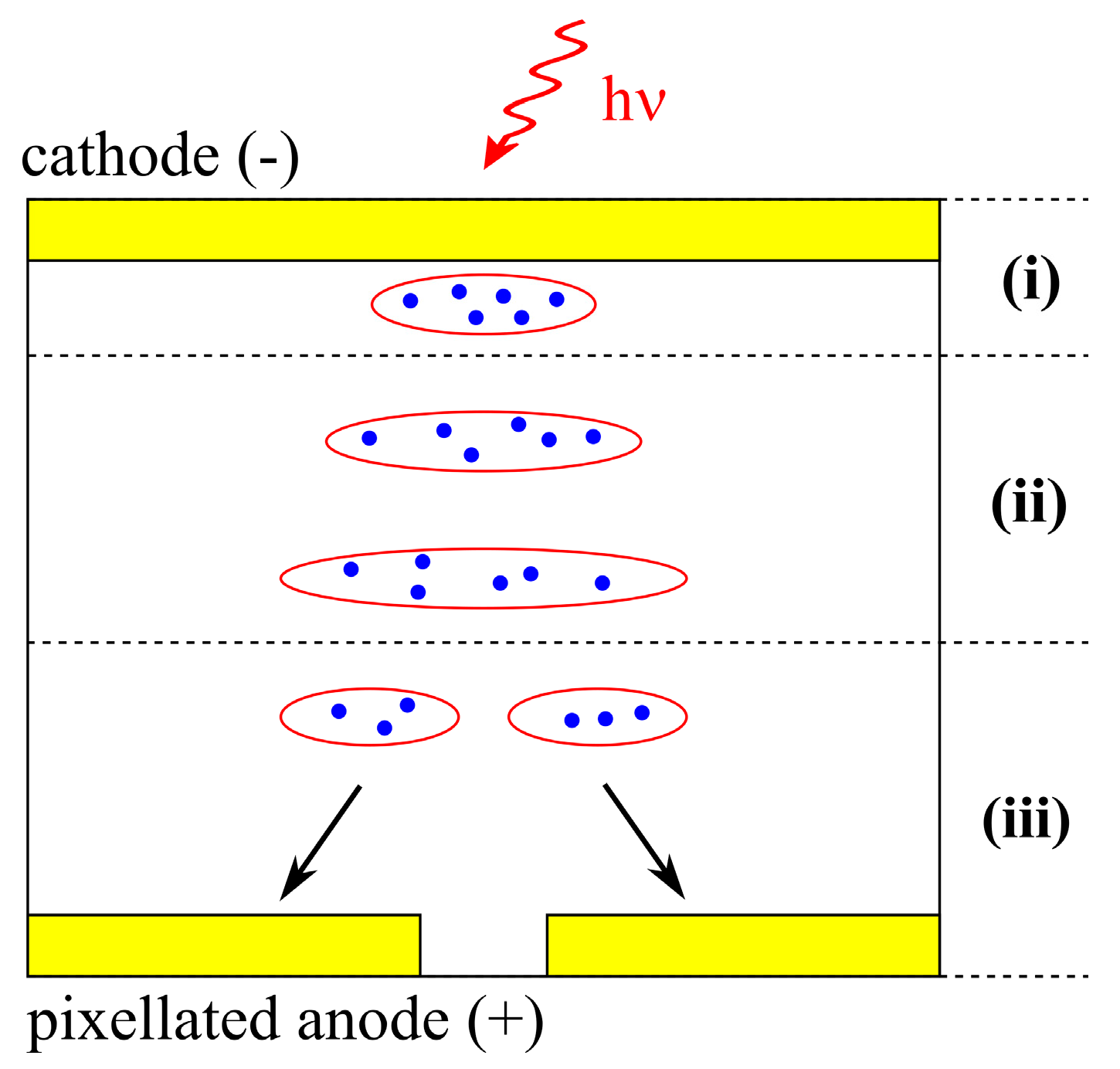
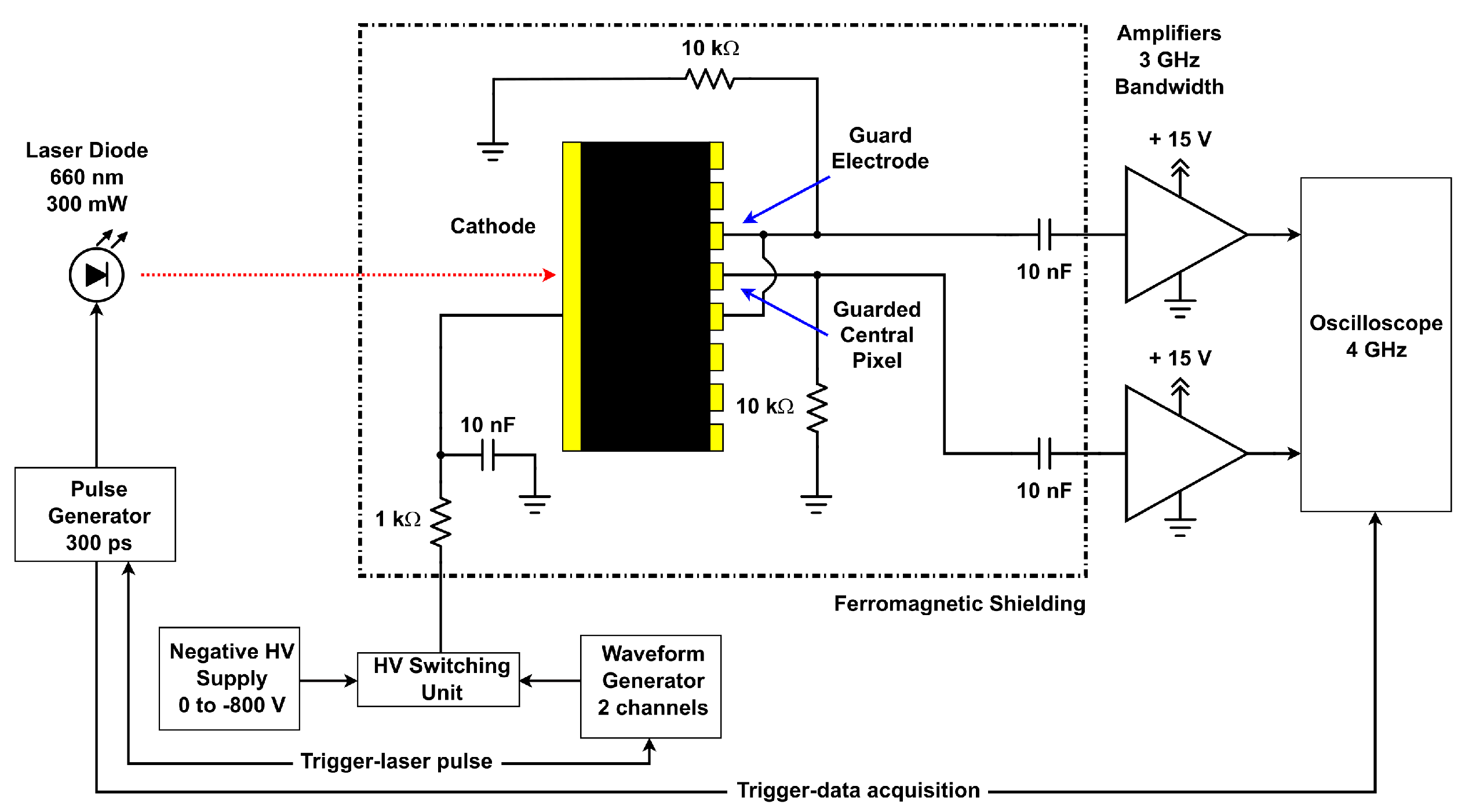
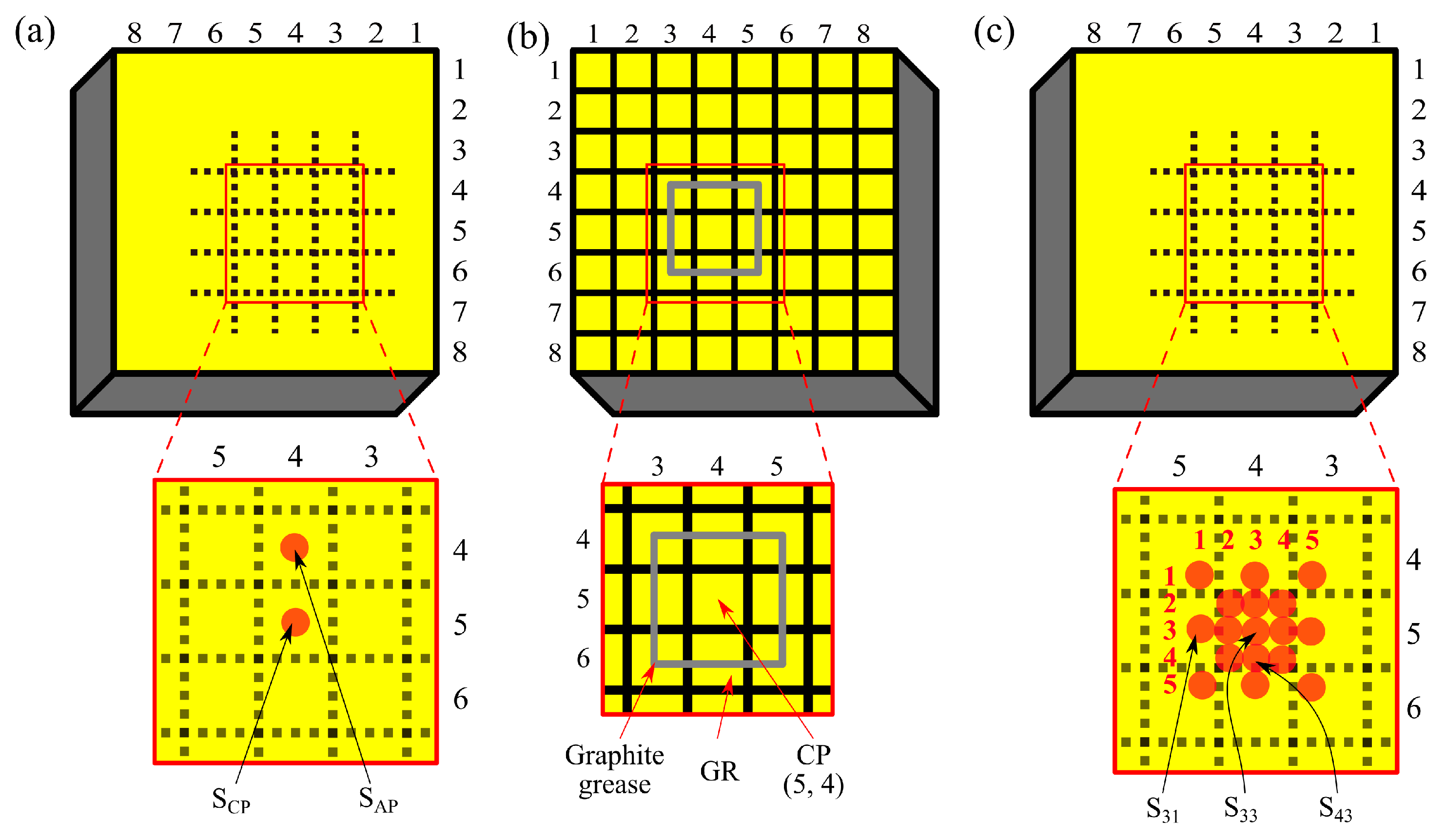
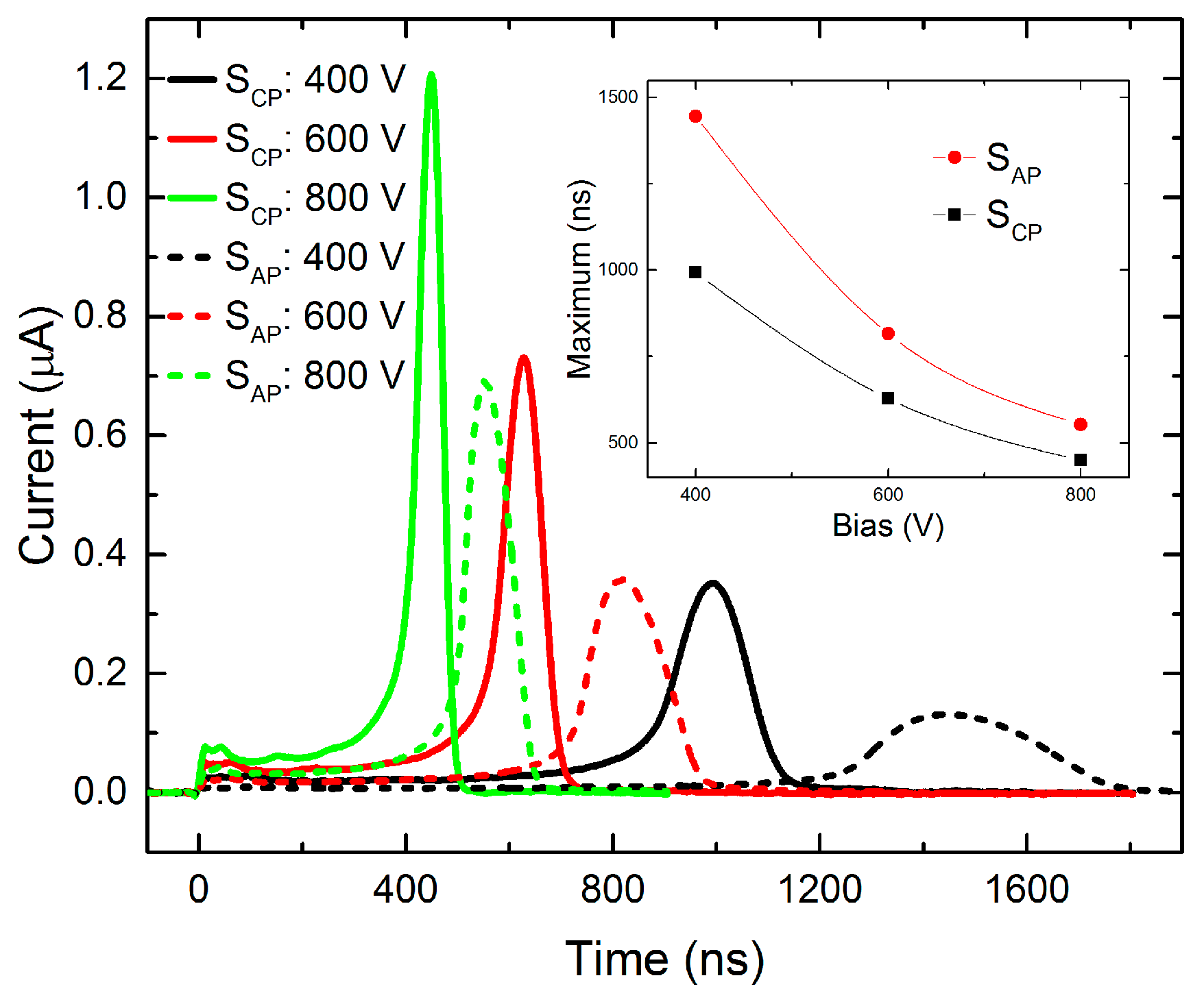
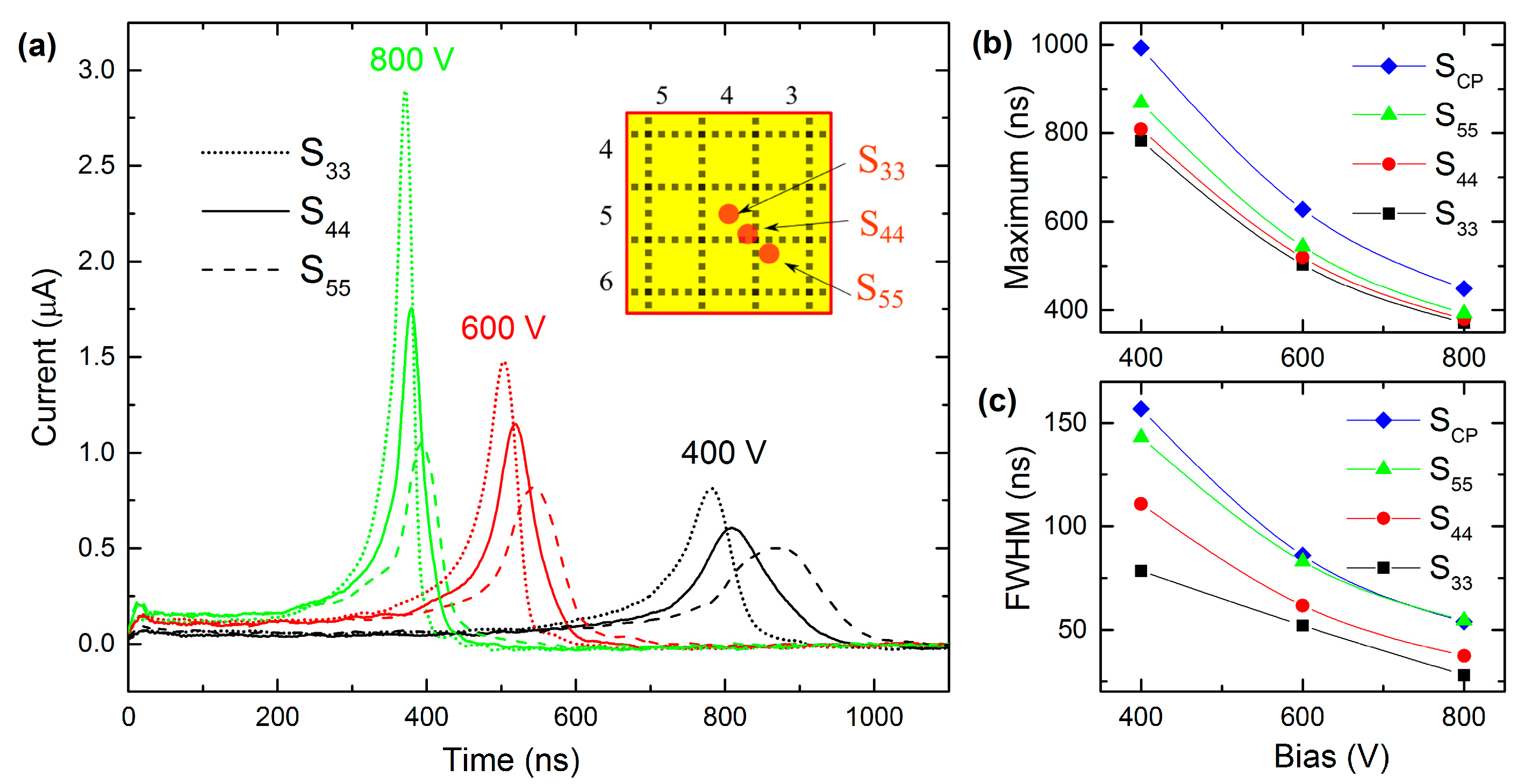



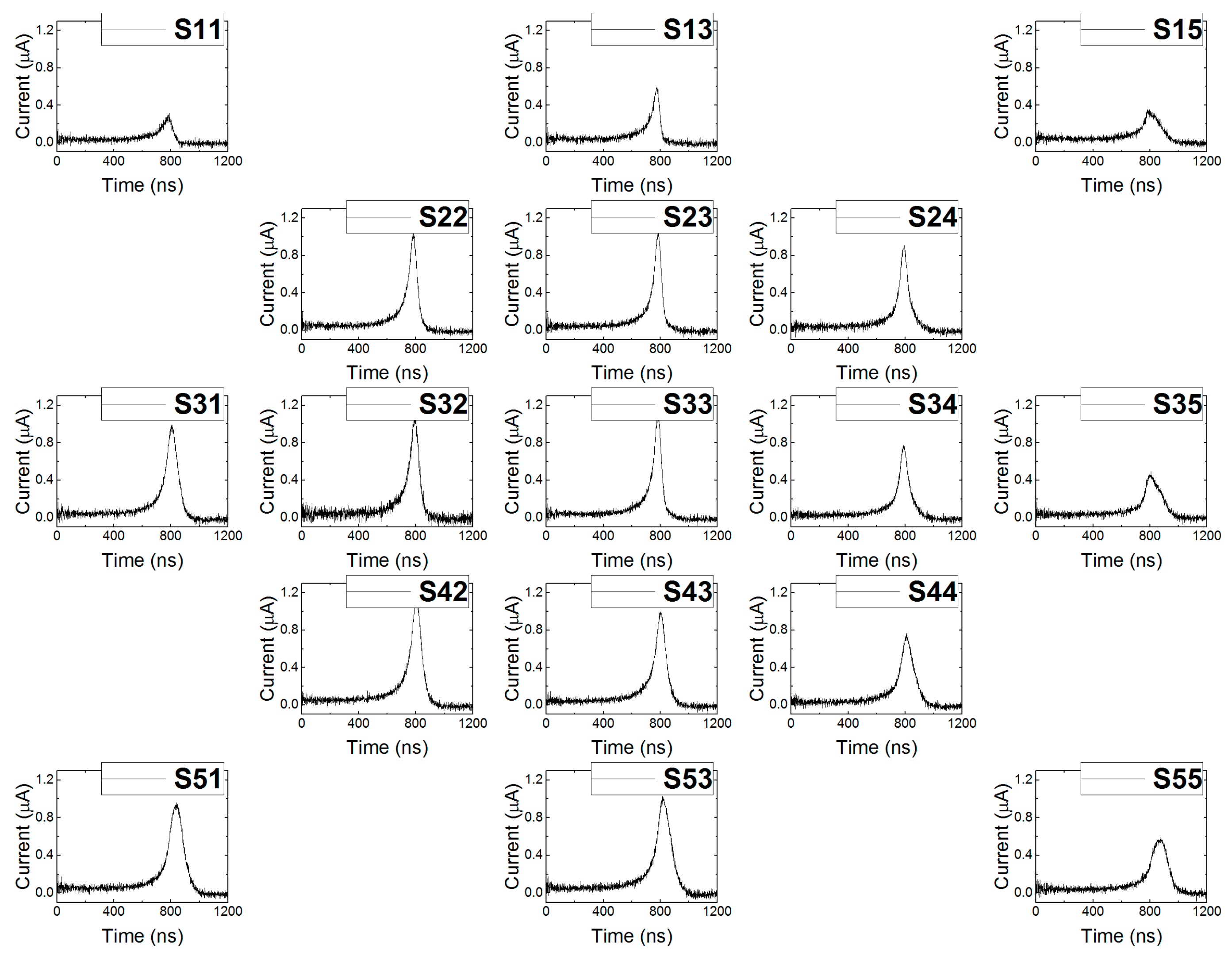
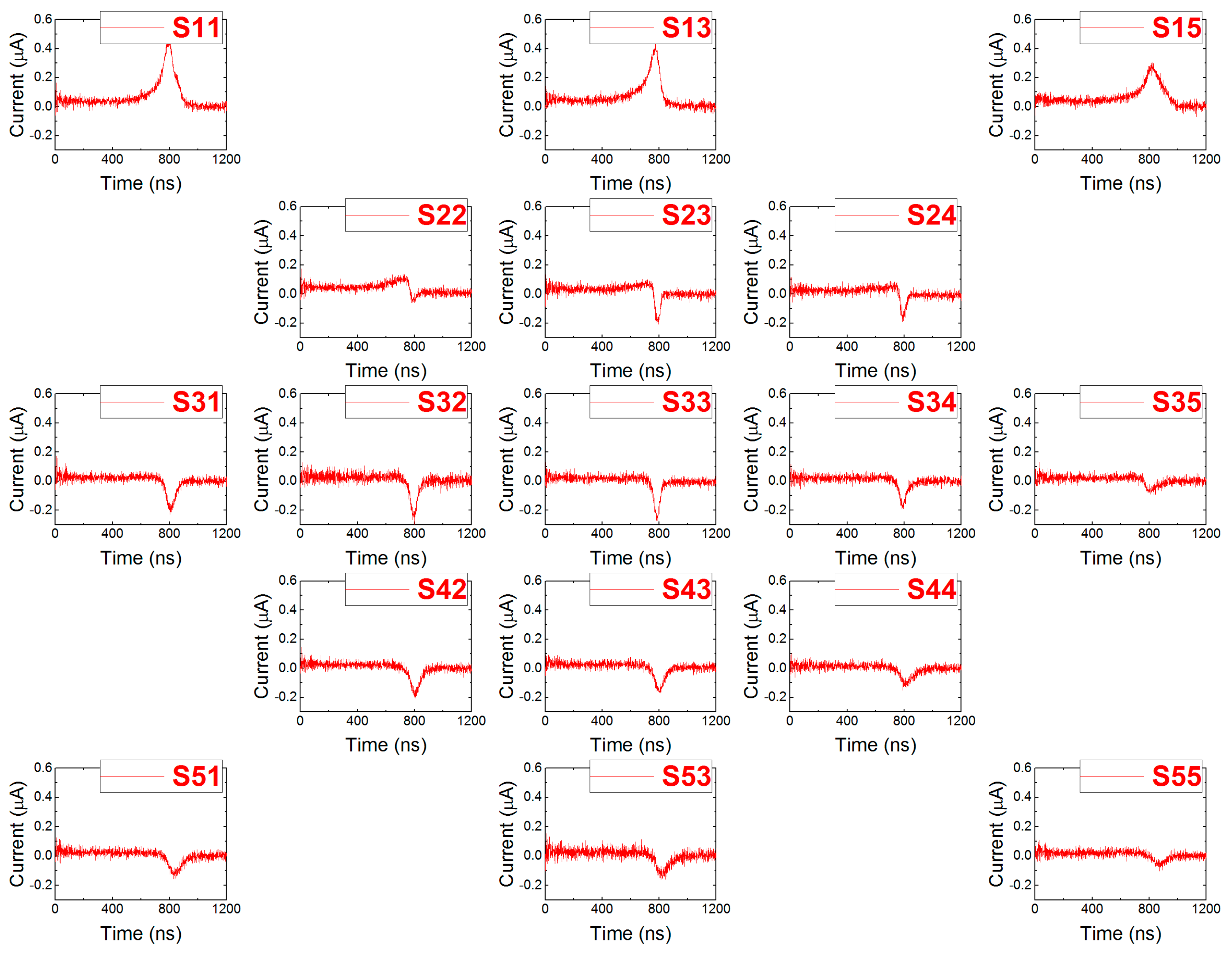
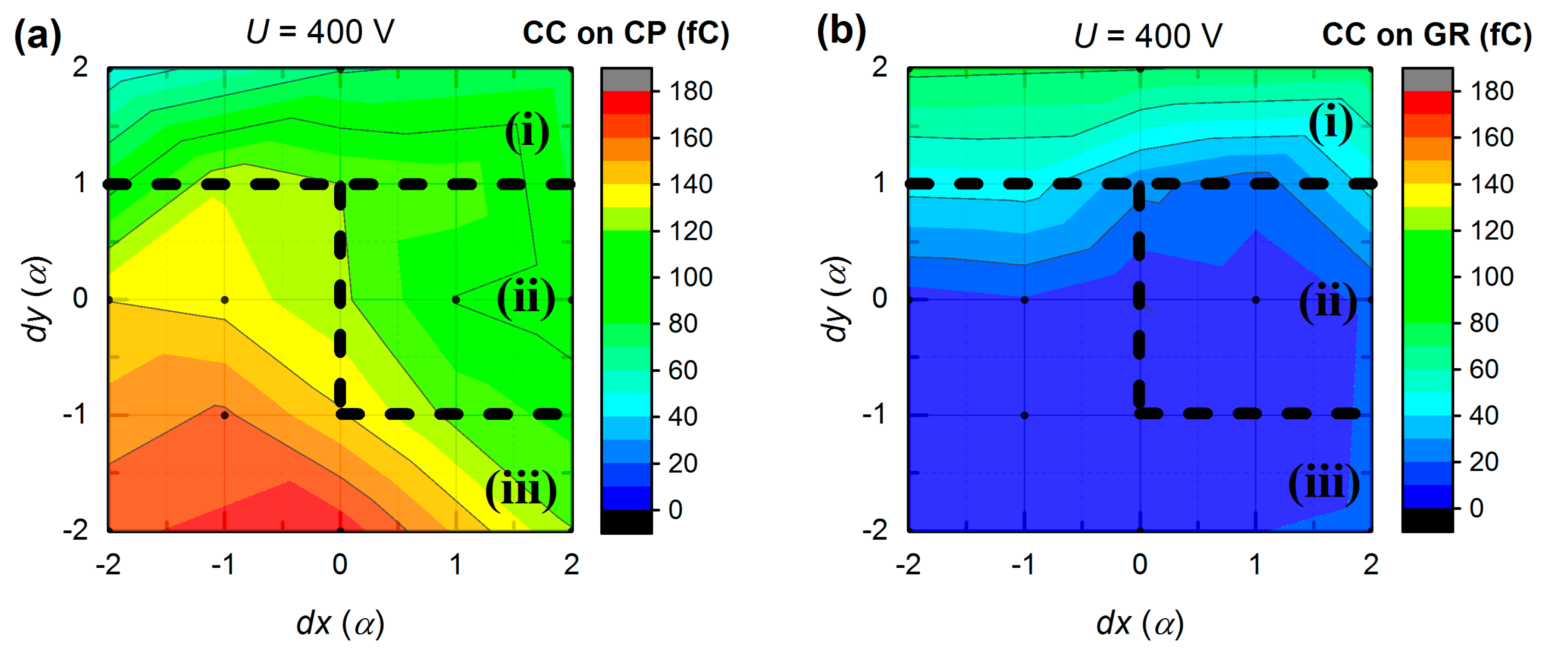
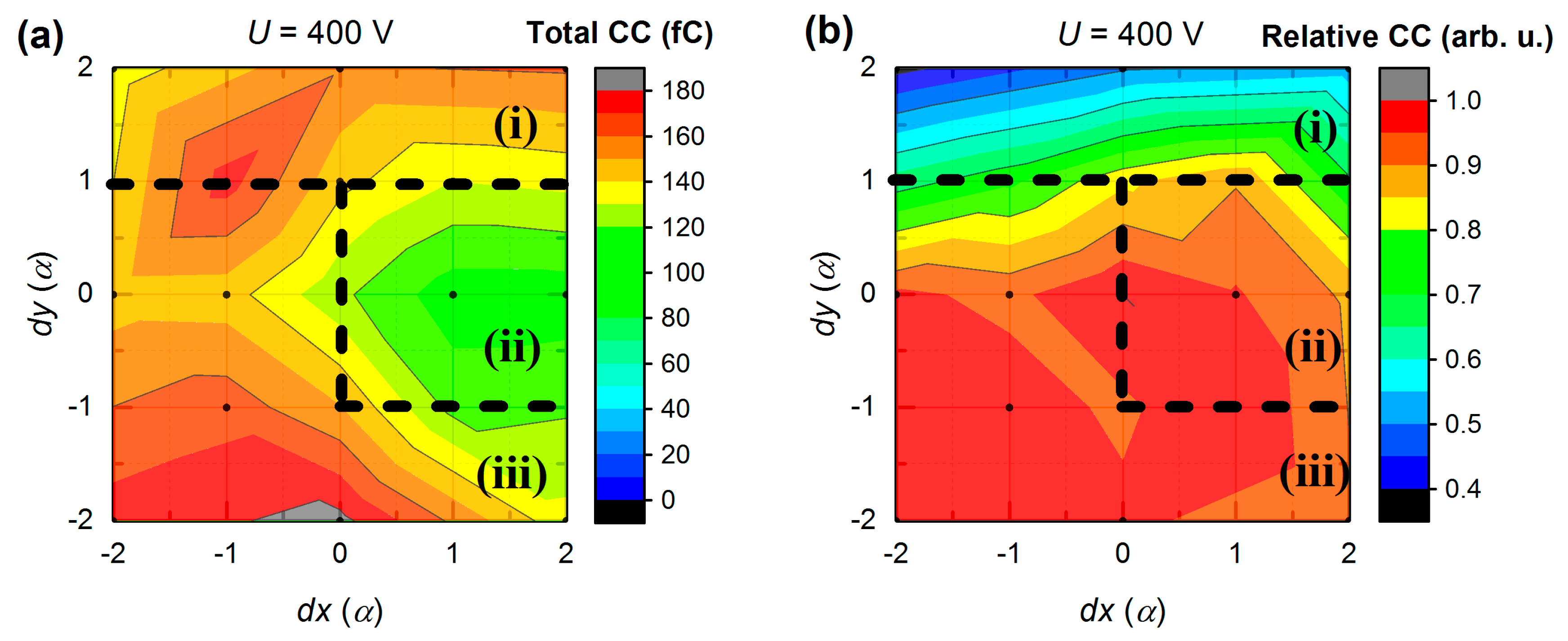
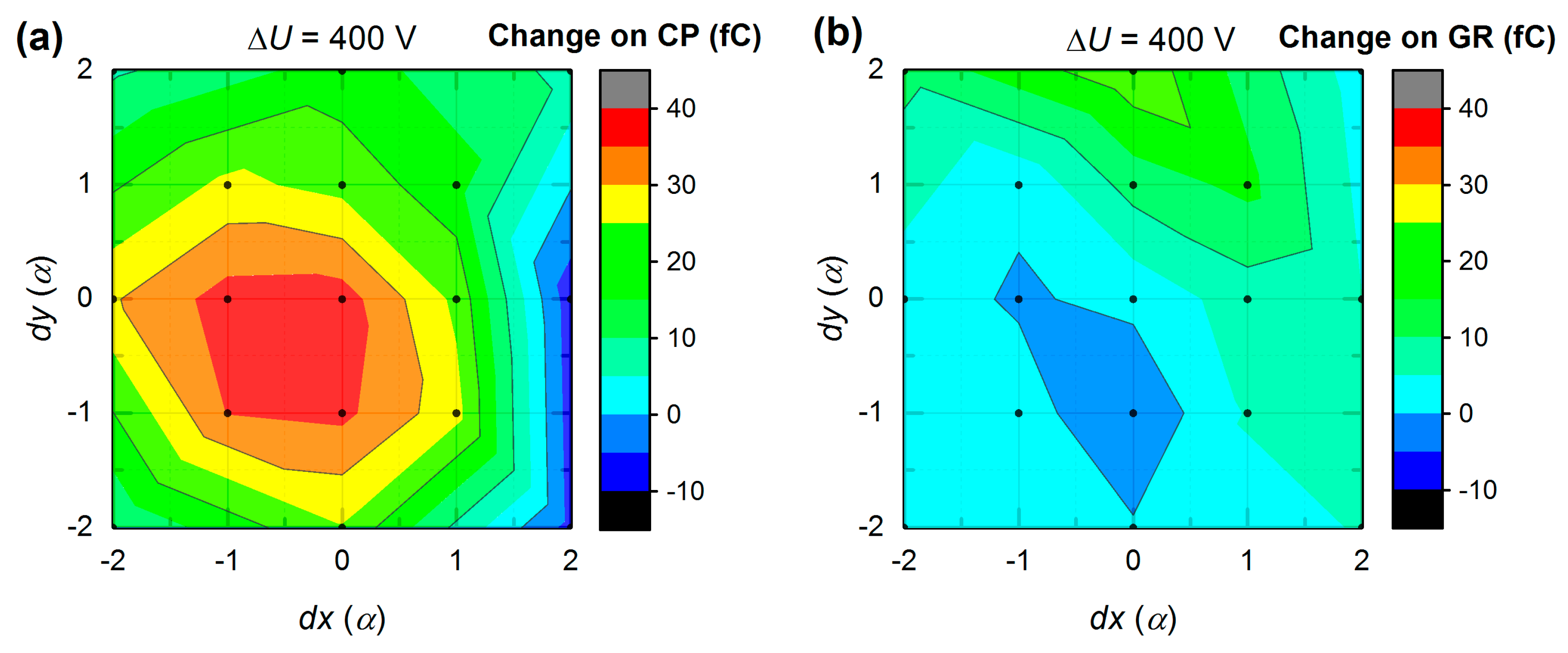
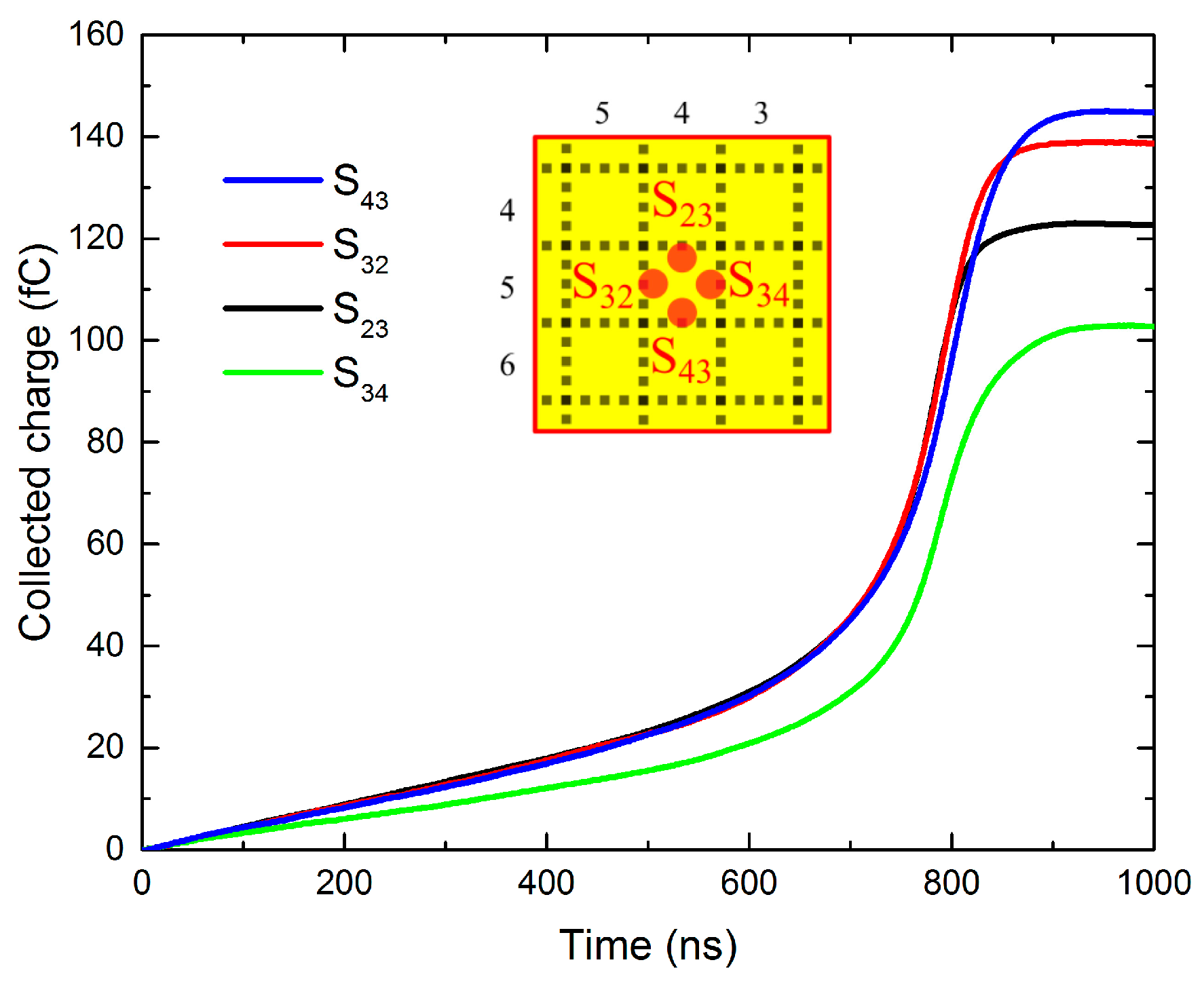
| Illuminated Spots | Distance FROM the Center of CP, mm |
|---|---|
| S33, SCP | 0 ± 0.0005 |
| S23, S32, S34, S43 | 0.85 ± 0.0005 |
| S22, S24, S42, S44 | 1.2 ± 0.0005 |
| S13, S31, S35, S53 | 1.7 ± 0.0005 |
| S11, S15, S51, S55 | 2.4 ± 0.0005 |
| SAP | 2.55 ± 0.0005 |
© 2019 by the authors. Licensee MDPI, Basel, Switzerland. This article is an open access article distributed under the terms and conditions of the Creative Commons Attribution (CC BY) license (http://creativecommons.org/licenses/by/4.0/).
Share and Cite
Vasylchenko, I.; Grill, R.; Belas, E.; Praus, P.; Musiienko, A. Charge Sharing in (CdZn)Te Pixel Detector Characterized by Laser-Induced Transient Currents. Sensors 2020, 20, 85. https://doi.org/10.3390/s20010085
Vasylchenko I, Grill R, Belas E, Praus P, Musiienko A. Charge Sharing in (CdZn)Te Pixel Detector Characterized by Laser-Induced Transient Currents. Sensors. 2020; 20(1):85. https://doi.org/10.3390/s20010085
Chicago/Turabian StyleVasylchenko, Igor, Roman Grill, Eduard Belas, Petr Praus, and Artem Musiienko. 2020. "Charge Sharing in (CdZn)Te Pixel Detector Characterized by Laser-Induced Transient Currents" Sensors 20, no. 1: 85. https://doi.org/10.3390/s20010085
APA StyleVasylchenko, I., Grill, R., Belas, E., Praus, P., & Musiienko, A. (2020). Charge Sharing in (CdZn)Te Pixel Detector Characterized by Laser-Induced Transient Currents. Sensors, 20(1), 85. https://doi.org/10.3390/s20010085





